Making authentic homemade Thai red curry paste from scratch is very simple. All you need are a few spices, fresh herbs, and a kitchen tool to help you make the tastiest, most fragrant, and most flavorful homemade red curry paste.
Once you make this Thai red curry paste recipe, use it immediately to make these AUTHENTIC, EASY, AND DELICIOUS Thai Red curry with Kabocha squash and Authentic Thai red curry recipes with chicken. Two authentic recipes that are very popular on my blog!

I frequently make large batches of curry paste at home, in cooking classes, and as a lead chef at a local restaurant. Over the years, I’ve refined my technique—balancing fresh herbs, spices, and aromatics—to achieve authentic Thai flavors. Whether I’m teaching students or developing restaurant menus, this foundational paste remains at the heart of many of my dishes.
Jump to:
- Why Make Your Own Curry Paste?
- Thai Red Curry Paste Recipe ingredients
- How to make Thai Red Curry Paste
- Tips for successful Red Thai Curry Paste
- How to store Curry Paste
- Curry Paste FAQs
- Recipes using Thai red curry paste
- More Thai Recipes You'll love
- Red Thai Curry Paste
- More authentic Thai curry pastes you'll love
Why Make Your Own Curry Paste?
- Making homemade curry paste is easier than you think! You need the right ingredients, and you are set!
- Making and using fresh curry pastes will change how you experience Thai curries. You will be able to taste and smell the exotic ingredients most delightfully. Trust me on this one. (:
- Finding ingredients for making Thai curry pastes is much easier now than ever. Most, if not all, of the ingredients, can be found at your local Asian market.
- Curry pastes freeze very well. You can freeze them in small portions in ice cube trays for easier measurements when ready to use in recipes. Once frozen, remove them from the ice trays and store them in air-tight containers to keep them fresh longer.
Thai Red Curry Paste Recipe ingredients
These are the key ingredients to make authentic Thai red curry paste. Not all the ingredients are listed here, but these are the essential ones that need a little explanation and possible substitutes.
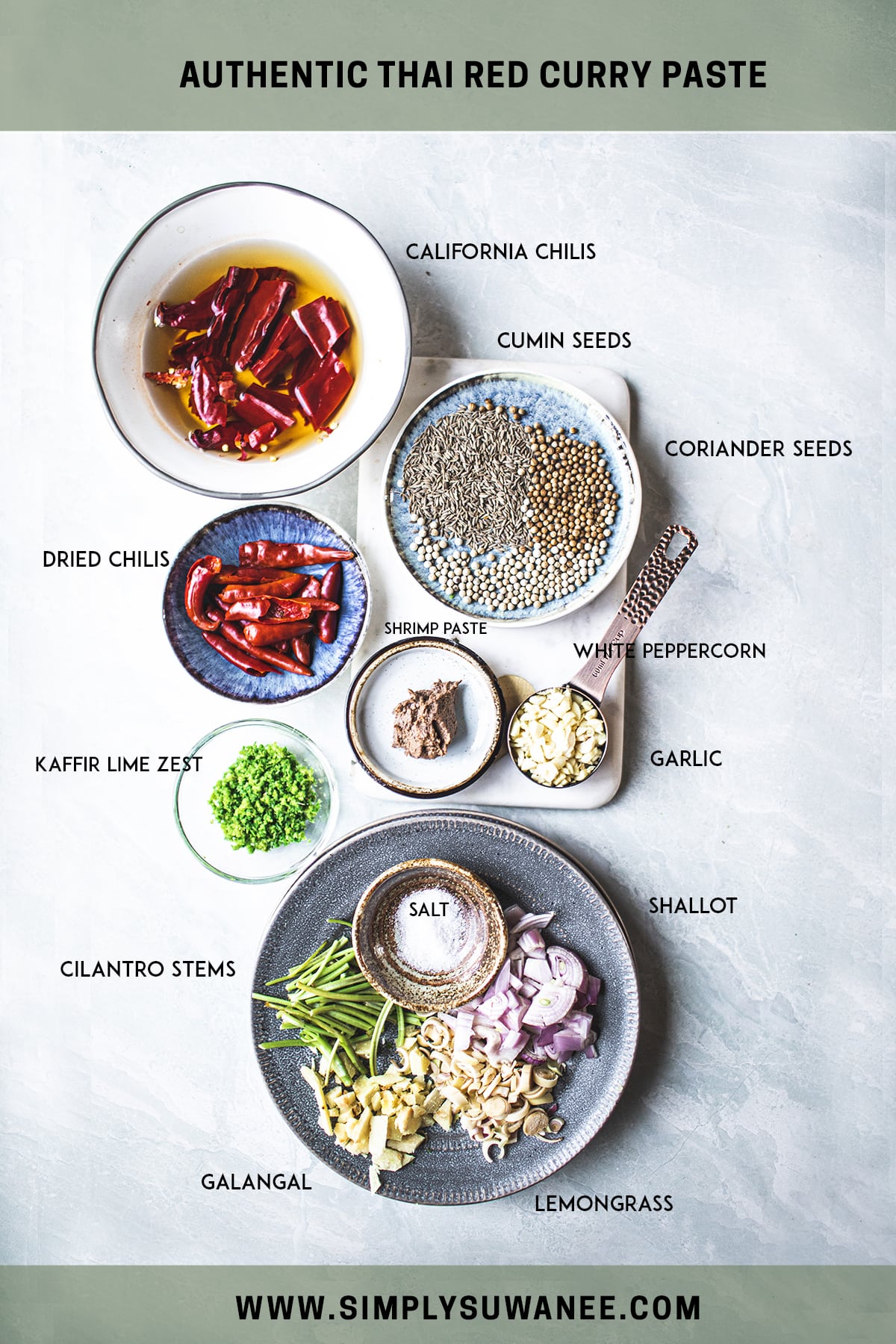
These are the key ingredients to make authentic Thai red curry paste.
Dry Spices for making red curry paste
- Dried red chilies. An essential ingredient for making curry paste. The spicy ones are Thai bird’s eye chilis, Piri Piri chilis, Thai long chilis (Prik Chee Fah), De Arbol, or dried Serrano chilis. The large chilis are used mostly for color and added flavors. Use dried California/Anaheim chilis or Gualillo. This dried chilis set is a good combination of spicy and mild dried chilis, perfect for making curry paste.
- White peppercorns are made from ripe black peppercorn berries. The skin is soaked and stripped, making the white peppercorns less spicy, but it generates a unique flavor and smell.
- Coriander seeds are easily found in the spice section of most Asian markets. Use the powder form if unable to find whole seeds.
- Cumin seeds. Use powder only if unable to find the seeds.
Wet or Fresh Ingredients for making Thai red curry paste
- Lemongrass. Use fresh lemongrass. Use the rounded lower 3-5 inches part of the stem. Chop the lemongrass stalks into small pieces before pounding for easy pounding. Frozen and chopped lemongrass is fine too. Read more about Lemongrass and how to use it in Thai cuisine.
- Galangal. Use fresh or frozen galangal only for Thai curry paste recipes. Never use dried or powdered galangal. Also, never substitute ginger for galangal. They are two completely different ingredients with different flavors and fragrances. Most, if not all, Asian markets will have fresh or frozen galangal. Read more about Galangal in Thai cooking here.
- Kaffir lime zest. This is the one ingredient you may not be able to find fresh, even in some well-stocked Asian markets. If you cannot find fresh kaffir limes, try this as a substitute. Use one lime zest plus 3-4 Kaffir lime leaves. If you can find key limes, use 3-4 key limes instead of 1 medium-sized lime. Key limes have a fragrant profile that is very nice to use as a substitute for kaffir limes. Read more about Kaffir limes and leaves and substitute here. Lemon zest could work, but you may need to add some extra.
- Cilantro roots or stems. Cilantro roots are rare in the US. Use the largest and lowest parts of the stems instead. They are also called coriander roots.
- Shrimp paste. I highly recommend Thai shrimp paste for authentic curry paste. The smell is potent, but the paste will add a very deep umami taste to your curry paste.
- Shallot. I don’t recommend substituting red onions for making curry pastes. You should easily find them in your local grocery stores.
- Garlic. Garlic is essential in making curry pastes.
- Salt. I recommend using kosher or Himalayan fine-grain salt. Salt preserves and adds flavor to the curry paste. Never use fish sauce for making curry pastes.
Helpful tools for this Curry Paste Recipe
- A solid stone mortar and pestle with at least a 6-inch opening.
- Food processor
- Spice grinder
- Kitchen scissor
- Small glass jars for storing any leftovers
- Food labeling
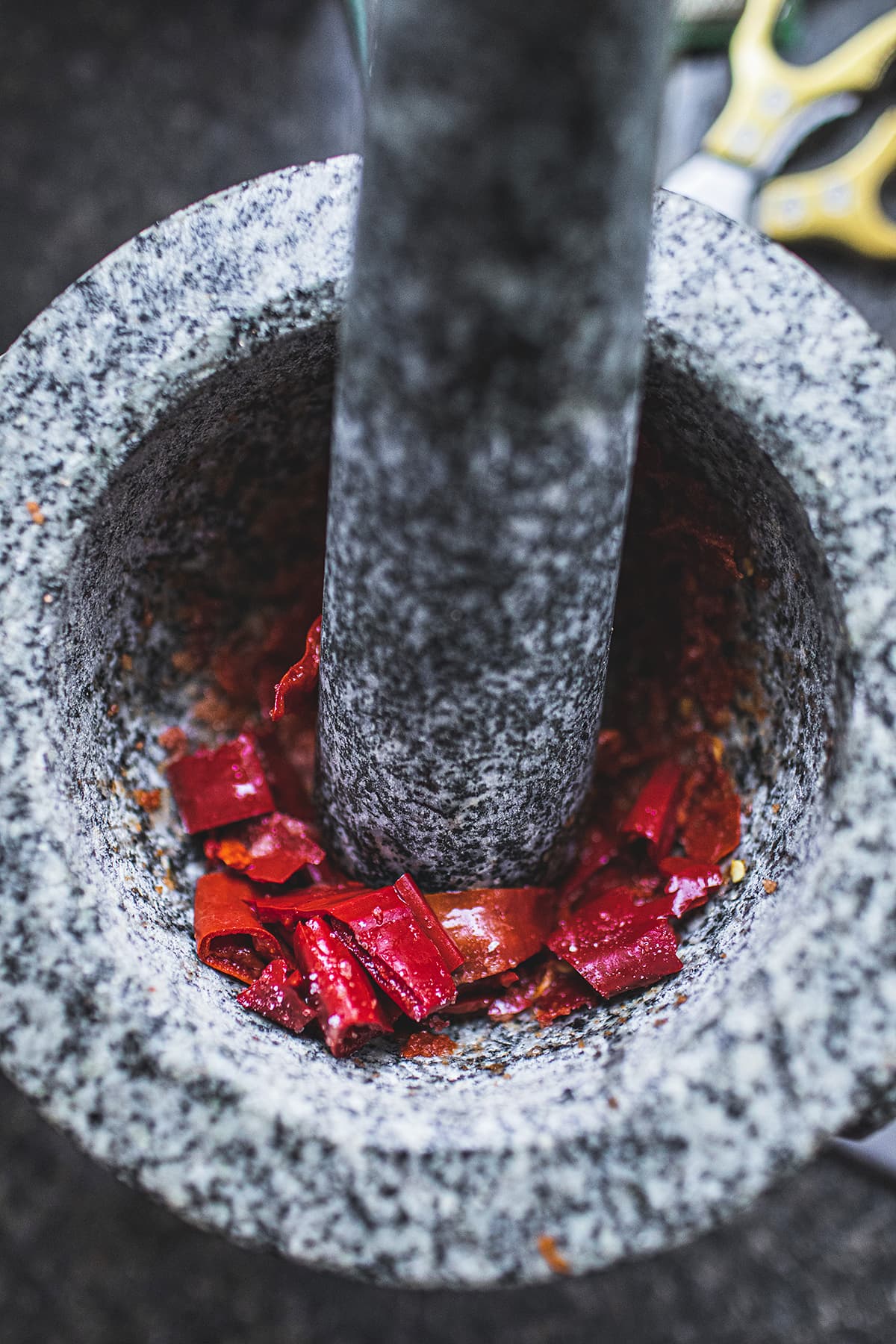
How to make Thai Red Curry Paste
I have two main methods for making Authentic Thai red curry paste. The first is the easiest and fasting, using a food processor or blender to mix all the ingredients. The second method uses the stone mortar and pestle to pound all the ingredients into a paste. This is more traditional have stronger flavors from the oils released from pounding all the ingredients together. Let's get started!
Using a Food Processor or Blender Method to make Thai red curry paste
If this is your first time making a curry paste, this method will be the easiest one to start with. Then perhaps the next time you do it again, check out the mortar and pestle method.

- Remove the stems and seeds of the chilis, then soak all the chilis in warm water for 15-20 minutes or until soft. Cut the large chilis into smaller 1-inch pieces before soaking. Save the water for use in the food processor.
- Toast cumin, coriander seeds, and white peppercorn on medium heat until fragrant for 2-3 minutes. Shaking the pan constantly to move the seeds around for an even toasting. Once fragrant and lightly toasted, remove from a pan into a plate to let cool.
- Use a spice grinder or a small mortar and pestle to ground the toasted seeds to powder. Place the freshly ground powder into a food processor.
- Drain, rinse, and pat the chilis dry. Use kitchen scissors to cut the soaked chilis into 1-inch pieces and place them in a food processor. Add the rest of the ingredients to the food processor. Add a little water,1 tablespoon at a time to help move the blades.
- Pulverized all ingredients together into a fine smooth paste. Add more water in small amounts as necessary.
- Remove the fresh curry paste for use. Done! Note the fresh flavors of a homemade curry paste. Glorious! Store unused paste in a glass jar, in the fridge for up to 14 days, and in the freezer for 3-4 months.
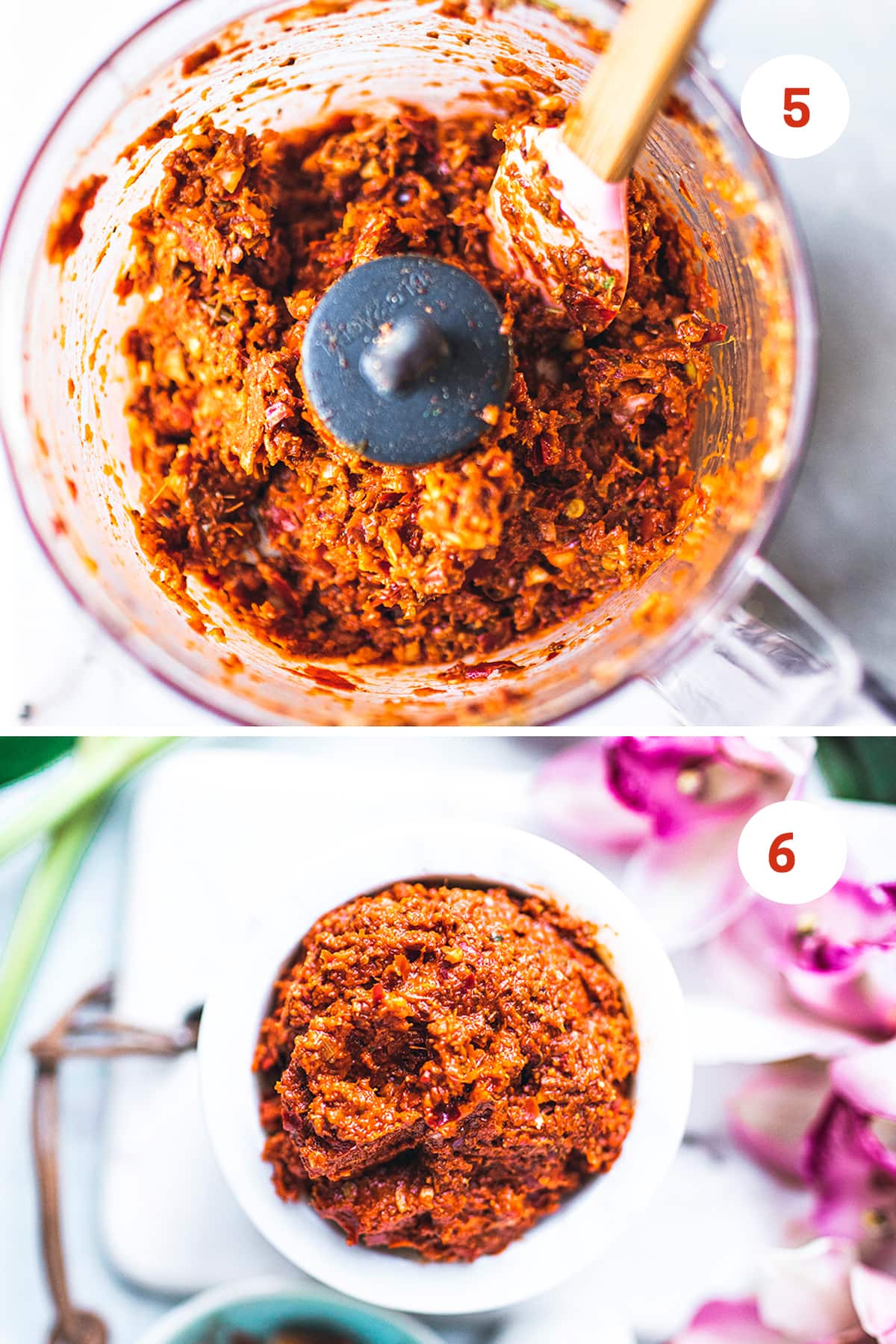
Using the Mortar and Pestle to make authentic Thai red curry paste
You will need a solid stone mortar and pestle for this method. I recommend using a medium-sized one with at least a 6 inches opening in width. When pounding, it's easier to start with the more fibrous and sturdy herbs and then move to softer ones towards the end.

- Remove the stems and seeds of the chilis, then soak all the chilis in warm water for 15-20 minutes or until soft.
- Toast cumin, coriander seeds, and white peppercorn on medium heat until fragrant for 2-3 minutes. Once fragrant and lightly toasted, remove from heat and let cool on a plate. Set aside.
- Drain, rinse, and pat dry the chilis. Use kitchen scissors to cut the chilis into 1-inch pieces and place them in the mortar with the salt. Start pounding with a pestle until smooth.
- Add the toasted spices and pound until smooth.
- Add the lemongrass and galangal and pound into the paste until smooth.
- Repeat the pounding of cilantro stems, shallots, garlic, and kaffir lime zest.
- Add the shrimp paste last and pound everything well until nice paste forms. Remove the paste and use it immediately for a curry. Enjoy the best Thai red curry paste from your very own kitchen! Refrigerate for up to 14 days. Freeze the paste for 4-6 months.
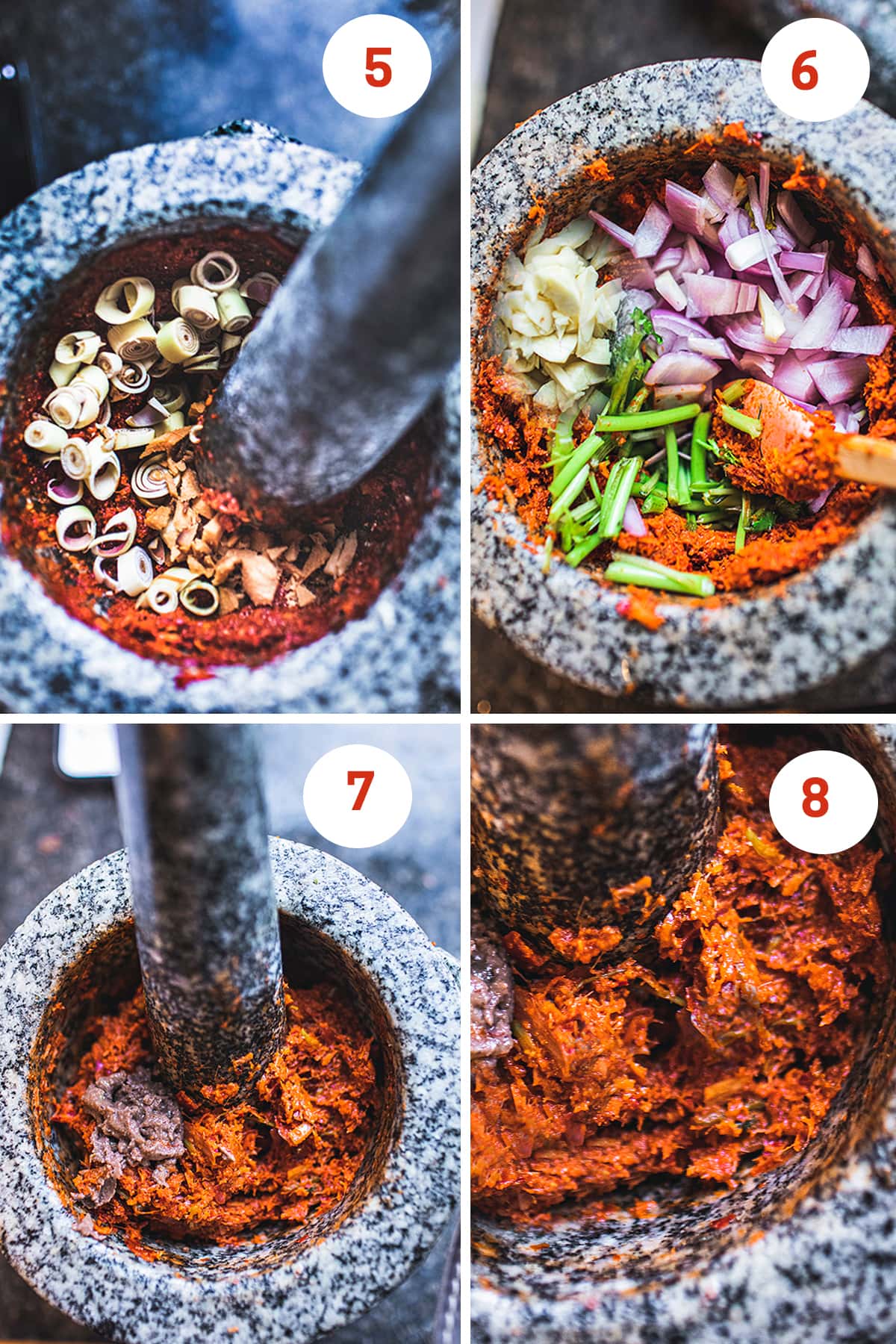
Tips for successful Red Thai Curry Paste
- You can adjust the heat level of your curry paste by how many peppers are used. The more you use, the spicier your paste will be. The smaller the chilis, also the spicer the paste. Use Thai bird's eye chilis cautiously, as they are extremely hot!
- The seeds of the small chilis are where all the heat of the peppers is stored. It’s important to remove the seeds, with a small knife, like a paring knife, before soaking to help reduce the heat and control the spiciness level. Use kitchen gloves to do this.
- Soak the larger dried chilies longer for easier pounding. I also find that the longer they soak, the more vibrant red my paste is. Very satisfying and pretty!
- This is VERY important: Use kitchen gloves when handling smaller chilis like Thai bird eye chilis, especially when deseeding them. The oil of the chili seeds is extremely hot and can burn your skin for hours. I’m speaking from experience! Wash your hands well with soap after you’re done.
- If short on time, place them in a bowl with water to cover all the chilis. Microwave the bowl for 2-3 minutes, then carefully remove it and let it sit until you are ready to use the peppers.
- When toasting the dry seeds, watch the pan closely and shake it often to prevent burning. The heat will quickly burn up the tiny seeds, so keep a close eye on them. Once a few seeds start popping, remove them from the pan and transfer them to a plate to let them cool.
- Freeze the leftover paste in small portions for easier measuring and thawing.
- Try the following tips for a more vibrant color in your curry pastes without compromising the recipes' authenticity and adding more Thai chilies. Use red bell peppers for red curry paste instead of adding red chilies. Use Thai basil or sweet green bell peppers for green curry paste instead of adding more green chilis.
How to store Curry Paste
Spoon your curry paste into an airtight container or sealable bag, then store it in the fridge for up to two weeks. For more extended storage, freeze it in portioned-out ice cube trays or small glass containers—perfect for quick and easy meals later on!
Can You Freeze Homemade Thai Curry Paste?
Homemade curry pastes last up to 2 weeks in the refrigerator and can freeze for up to 6 months in an airtight container! If freezing, divide the paste into small portions for easy measurement so you don’t have to thaw the entire batch before measuring for use in recipes.
Curry Paste FAQs
Thai curry pastes are made from fragrant herbs and dried spices. The main ingredients are dry, spicy red pepper, garlic, shallot, cilantro roots or stems, lemongrass, kra chai, galangal, kaffir lime zest, and fresh or dried chili peppers (depending on what curry you are making).
The dried spices used are coriander, cumin, white peppercorn, fennel, turmeric, cinnamon, cardamom, and others used for different curries.
There is no substitute for Thai curry paste. The pastes are unique, with flavors from fragrant herbs and spices used. A curry paste is a must for curry recipes. If you are worried about the heat, try using less paste, or even better yet, make your paste with my recipe here! You can control the spice level when making homemade curry pastes.
The most popular Thai curry pastes are red, green, yellow, Panang, and Massaman curry paste. They are all different and delicious, and it comes down to your taste bud and what you like! There are many different curry pastes in Thai cuisine. Each curry paste has its unique flavor profile using different combinations of herbs and spices.
Maybe. It depends on what curry powder you have and what curry paste you try to make. Curry powder is a pre-made blend of different spices to use as a whole ingredient for a recipe. You'll need curry powder to add to the paste in some Thai yellow curry pastes. I hope this answers your question!
No, they are two different things, and each has different uses for different recipes. Thai red chili pastes are typically a relish or sauce with different tastes and ingredients, while red curry paste is a base used for many Thai curries. Chili paste and curry paste cannot be used as substitutes for one another.
Recipes using Thai red curry paste
Thai red curry paste is the most widely used curry in Thai cuisine. It is a base for many other curries like Massaman, Choo Chee, Thai Swimming Rama, and Thai vegetarian red curry with noodles. Red curry paste is also used in many Thai dishes for stir-fries and soups. It's a good paste to know how to make if you love Thai food.
More Thai Recipes You'll love
- Thai red curry with chicken and kabocha squash, known as Prik Gaeng Ped.
- Authentic Thai green curry paste
- Authentic Thai red curry recipe
- Easy red curry green beans with shrimp, Pad Prik Khing
- Pad Prik Khing with pork belly
- Lemongrass and how to use it in Thai cuisine
- Galangal in Thai cooking
- Kaffir lime leaves and substitute
- Choo Chee curry with salmon, with a rice creamy curry sauce
- Easy Thai yellow curry chicken, an easy curry recipe with bamboo shoots and chicken
- Pad Mee, a delicious Thai rice noodles dish
* Love a recipe you've tried? Please leave a 5-star rating in the recipe card below and/or a review in the comments section further down the page. Or follow me on Facebook, Pinterest, or Instagram! **
Print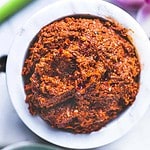
Red Thai Curry Paste
- Total Time: 30 minutes
- Yield: ½ cup
- Diet: Low Calorie
Description
Making authentic homemade Thai red curry paste from scratch is very simple. All you need are a few spices, fresh herbs, and a kitchen tool to help you make the tastiest, most fragrant, and most flavorful homemade red curry paste.
Ingredients
- 7-10 long-dried chilis, deseeded & stems removed (wear gloves when handling hot chilis)
- 2 California chilis deseeded and stemmed removed.
- 2 teaspoons salt
- ½ teaspoon whole white peppercorn
- ½ teaspoon cumin seeds
- 1 ½ teaspoons coriander seeds
- 2 teaspoons galangal, chopped small
- 2 tablespoons lemongrass, finely chopped
- 2 tablespoons cilantro stems or roots, chopped small
- 1 tablespoon garlic, chopped small
- ⅓ cup shallot, diced small
- 1 teaspoon kaffir lime zest or *substitute* ½ teaspoon lime zest + 1 kaffir lime leaves
- 2 teaspoons shrimp paste
- 1-3 tablespoons water *as needed only
Instructions
Using a Food Processor or Blender Method
If this is your first time making a curry paste, this method will be the easiest one to start with. Then perhaps the next time you do it again, check out the mortar and pestle method.
- Remove the stems and seeds of the chilis, then soak all the chilis in warm water for 15-20 minutes or until soft. Cut the large chilis into smaller 1-inch pieces before soaking. Save the water for use in the food processor.
- Toast cumin, coriander seeds, and white peppercorn on medium heat until fragrant for 2-3 minutes. Shaking the pan constantly to move the seeds around for an even toasting. Once fragrant and lightly toasted, remove from a pan into a plate to let cool.
- Use a spice grinder or a small mortar and pestle to ground the toasted seeds to powder. Place the freshly ground powder into a food processor.
- Drain, rinse, and pat the chilis dry. Use kitchen scissors to cut the soaked chilis into 1-inch pieces and place them in a food processor. Add the rest of the ingredients to the food processor. Add a little water,1 tablespoon at a time to help move the blades.
- Pulverized all ingredients together into a fine smooth paste. Add more water in small amounts as necessary.
- Remove the fresh curry paste for use. Done! Note the fresh flavors of a homemade curry paste. Glorious! Store unused paste in a glass jar, in the fridge for up to 14 days, and in the freezer for 3-4 months.
Using the Mortar and Pestle
You will need a solid stone mortar and pestle for this method. I recommend using a medium-sized one with at least a 6 inches opening in width. When pounding, it's easier to start with the more fibrous and sturdy herbs and then move to softer ones towards the end.
- Remove the stems and seeds of the chilis, then soak all the chilis in warm water for 15-20 minutes or until soft.
- Toast cumin, coriander seeds, and white peppercorn on medium heat until fragrant for 2-3 minutes. Once fragrant and lightly toasted, remove from heat and let cool on a plate. Set aside.
- Drain, rinse, and pat dry the chilis. Use kitchen scissors to cut the chilis into 1-inch pieces and place them in the mortar with the salt. Start pounding with a pestle until smooth.
- Add the toasted spices and pound until smooth.
- Add the lemongrass and galangal and pound into the paste until smooth.
- Repeat the pounding of cilantro stems, shallots, garlic, and kaffir lime zest.
- Add the shrimp paste last and pound everything well until nice paste forms. Remove the paste and use it immediately for a curry. Enjoy the best Thai red curry paste from your very own kitchen! Refrigerate for up to 14 days. Freeze the paste for 4-6 months.
Notes
- You can adjust the heat level of your curry paste by how many peppers are used. The more you use, the spicier your paste will be. The smaller the chilis, also the spicer the paste. Use Thai bird's eye chilis cautiously, as they are extremely hot!
- The seeds of the small chilis are where all the heat of the peppers is stored. It’s important to remove the seeds, with a small knife, like a paring knife, before soaking to help reduce the heat and control the spiciness level. Use kitchen gloves to do this.
- Soak the larger dried chilies longer for easier pounding. I also find that the longer they soak, the more vibrant red my paste is. Very satisfying and pretty!
- This is VERY important: Use kitchen gloves when handling smaller chilis like Thai bird eye chilis, especially when deseeding them. The oils of the chili seeds are extremely hot and can burn your skin for hours. I’m speaking from experience! Wash your hands well with soap after you’re done.
- Here's a quick tip. If you are short on time or if you forget to soak the dried chilis, place them in a bowl with water to cover all the chilis. Microwave the bowl for 2-3 minutes, then carefully remove it and let it sit until you are ready to use the peppers.
- When toasting the dry seeds, watch the pan closely and shake it often to prevent burning. The heat will quickly burn up the tiny seeds, so keep a close eye on them. Once a few seeds start popping, remove them from the pan and transfer them to a plate to let them cool.
- Freeze the leftover paste in small portions for easier measuring and thawing.
- Try these next tips for a more vibrant color in your curry pastes without compromising the authenticity of recipes and without adding more Thai chilies. Use red bell peppers for red curry paste instead of adding red chilies. Use Thai basil or bell peppers instead of adding more green chilis for green curry paste. The basil leaves will add extra fragrance to the paste as well.
** Thank you so much for visiting my blog! This is truly a passion for me. If you have enjoyed these recipes and appreciate the hard work I put into them, I would love it if you would share them with your friends! Your recommendation is the highest review I could hope for, and I’d appreciate it! **
- Prep Time: 15
- Cook Time: 15
- Category: Curry
- Method: Food processor
- Cuisine: Thai
More authentic Thai curry pastes you'll love
- Thai Tom Yum Paste
- Authentic Thai Green Curry Paste (พริกแกงเขียว)
- Authentic Thai Yellow Curry Paste
- The Best Authentic Thai Panang Curry Paste Recipe
- The Best Authentic Thai Massaman Curry Paste Recipe
- Authentic Homemade Choo Chee Curry Paste
- Prik Khing Thai Curry Paste, แกงพริกขิง
- How to Make Thai Chili Paste, Nam Prik Pao

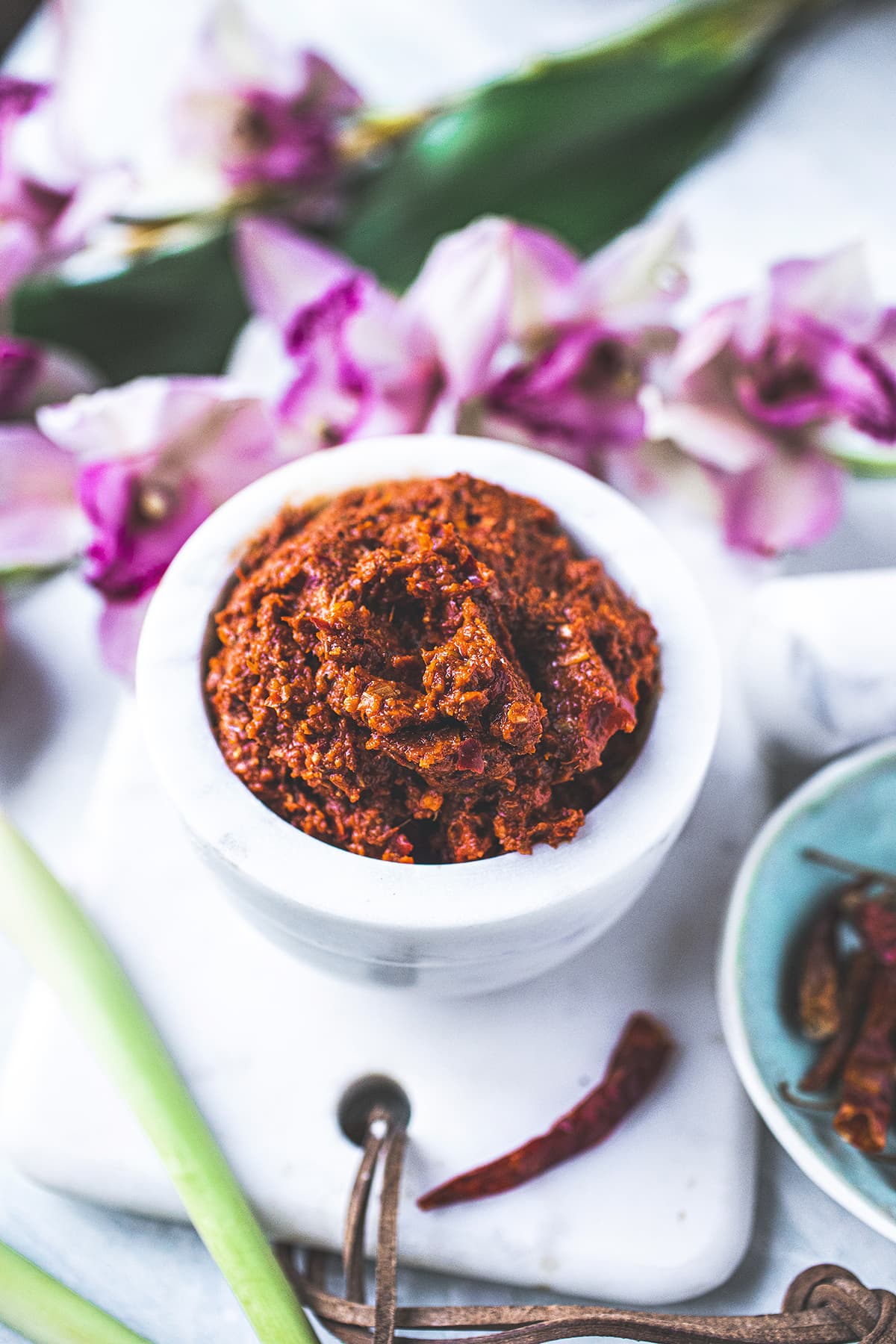
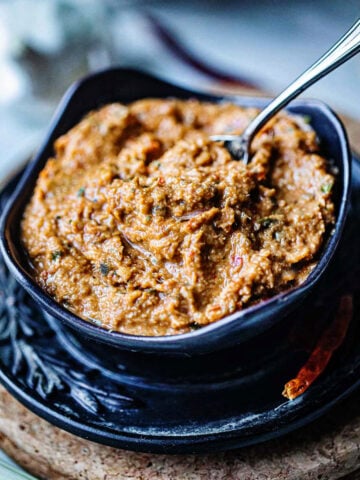

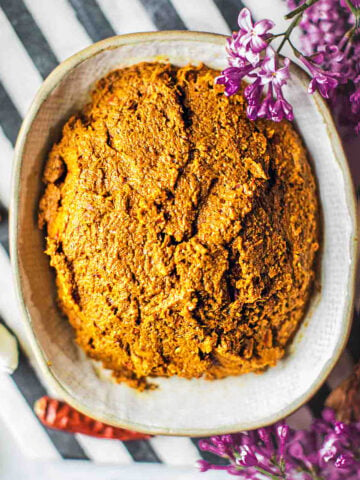
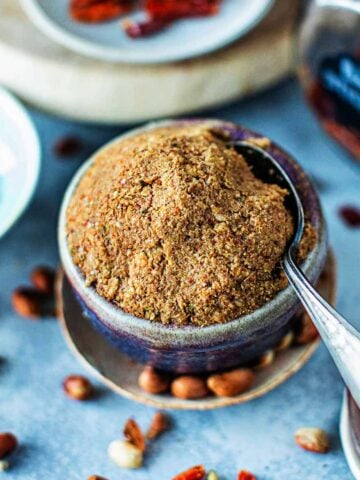
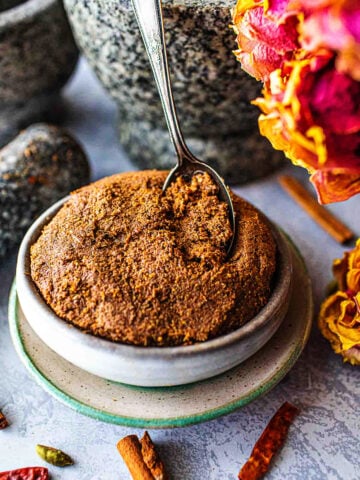

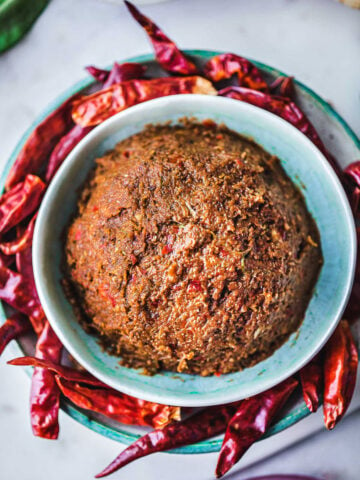
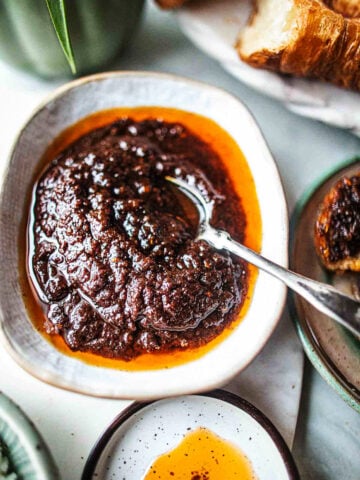
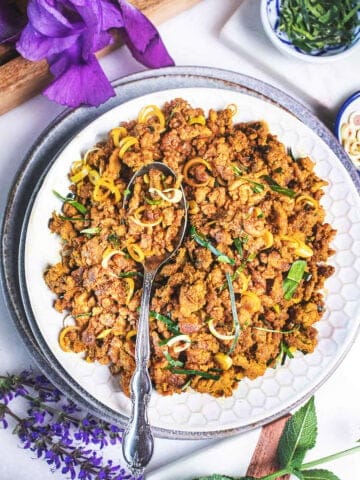
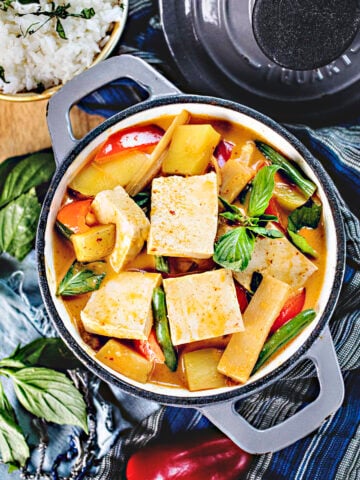
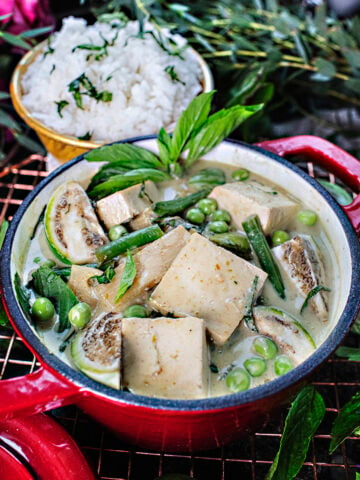

Suwanee says
You should give it a try, Susan! and then please let me know, I would love to hear your result very much. I bet it's going to be milder and earthy? Hope you experiment and share your results! (:
Here's a link to the white pepercorn if you can't find them near you. I typically order mine online from amazon and grind the whole seeds a small batch as at a time to keep them fresh.
https://amzn.to/45aSqaw
susan says
Very interesting about white peppercorns. I wondered where they came from! And I also notice they are harder to find!
I wonder what will happen if i make your red curry paste with cayenne peppers? I was gifted many plants in the spring so my garden is rife with cayenne this year!
Suwanee says
Nice job, Brindha! Impressive that you have most of those ingredients in your kitchen. isn't it satisfying to make your own homemade paste?
Brindha Dyer says
I had most of the ingredients at home - only galangal I had to pick up. So glad I did ! This was delicious and surprisingly easy to make.
Bernadette Sevajee says
This is the best curry recipe I’ve ever tried. It’s so easy as I can make it in advance and be able to cook easily with the paste even on a busy day. I’ve tried it for different chicken and fish n it’s simply yummy.
Adlyn A says
I am a fan on making curry pastes from scratch and this Thai curry paste hits all the right notes. Simple yet so delicious. Curious to know if there is a non-spicy version would work well, ie omitting this chilis?
Christina B says
What a flavorful paste! Just like I remember it in Thailand! Thank you!
Markel says
Never thought I could make this at home before. What a fun and delicious adventure!
Suwanee says
Thank you, lily!
Suwanee says
Thank you so much, Rebecca! Happy to hear it's helpful!
Rebecca says
The BEST recipe!!! There's just no comparison between this and store bought. Thank you for your tips on sourcing the ingredients. I'm new to Thai cooking and you made it SO easy for me. I deeply appreciate all the time you put into these detailed recipes.
Suwanee says
Thank you so much, Cassie!
Suwanee says
Thank you so much, Lizie!
Suwanee says
I'm so happy to hear this post was helpful for you, Lily!
Lily K says
Red curry has always been my favorite curry so no surprise that I love this recipe. I like 2-3 stars spicy on curry and this is perfect. You can taste the authentic spices and ingredients perfectly. Who knew that curry paste could be frozen for 3-4 months??!!
Lizie says
Fantastic recipe with excellent tips!
Cassie says
This paste definitely elevates our curry dishes! It’s so easy and worth it. Highly recommend!
Gomez says
Me gusta el fuego! Sabe buenissimo!
Mariam Whitmann says
What a detailed post! It's incredibly helpful to have the step-by-step photos to go along with the written instructions, thank you! I made this Thai red curry paste twice now using the food processor and both time came out perfect. My curries never tasted more fresh & fragrant!
Julie Judd says
Excellent Recipe!
Shelly Larsen says
So happy we found this recipe for Thai Red Curry paste. So flavorful. You are our new "go to" blog for real, authentic Thai Food; thanks for your informative posts.
Bob Delaney says
This red curry paste is the BEST. I make a big batch and freeze what I don't use. Really authentic and flavorful. We have really been enjoying your recipes.